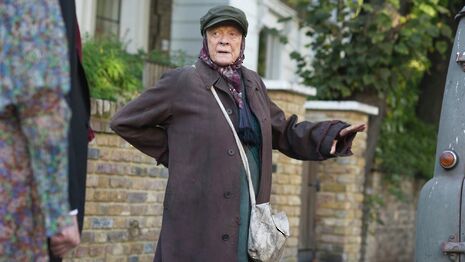Film: The Lady in the Van
“Whether you’re an Alan Bennett fan, a Maggie Smith fan, or just a fan of the elderly, this is a film that’s well worth a trip to the Picturehouse.”

Swooping around with bulging eyes, releasing a cornucopia of grunts, squeals and squawks, and ignoring every rule of regular social conduct in her sight, this Lady in the Van immediately reminded me of someone, though I couldn’t put my finger on whom. When mid-way through the film she proudly emerged with a new three-wheel car, the comparison was unmistakable. She reminded me of Mr. Bean. And just like Rowan Atkinson’s bumbling man-child, the Lady in the Van (or "Mary Shepard" as some call her, though she is travelling ‘incognito’) is someone you would never want to live with but is an unabashed joy to watch from a safe distance.
That said, she has considerably more edge than Mr. Bean. Watching the trailer, I had thought that this might be a film that made her an entirely lovable eccentric, a cute old lady. If there is one thing Mary is not, it is cute. She is old, poor and homeless, a cantankerous Catholic, rude to those who support her, and vicious to anyone who even thinks about playing a recorder in her vicinity. Perhaps she is better described as a mix of Mr. Bean and an elderly Professor McGonagall. Maggie Smith, who first played this character 16 years ago when it was a stage play, is a force of nature, summoning up fury and willpower while never losing a sense of fragility. There was a moment in the film when she disappeared for five or ten minutes, and I was already painfully aware of her absence.
Every Johnson needs a Boswell, and Mary Shephard’s is the writer of this screenplay himself, Alan Bennett, played by Alex Jennings in a perfectly understated performance. Timid, meditative and self-indulgent, he is most frequently seen peering out the window, drinking tea at his writing desk, and conversing with an imagined double of himself (also played by Alan Jennings). This is 1970s Camden Town, and the film’s bright colour palette, along with Alan’s endearingly indecisive personality, made an enjoyable foil to the elemental Mary, who as the film progresses becomes somehow more, not less, intractable (not to mention incontinent).
This is, after all, a film with a great deal of ugliness in it, and I’m not referring just to the less hospitable parts of Mary’s personality. Old age and poverty are neither overlooked nor glamourised (Mary’s smell is something almost every character comments on). But there is also beauty, particularly in the film’s music, which opens and closes the film with aplomb.
When translating stage plays into films, one can sometimes get a feeling of empty space. In dialogue-heavy scripts, the sheer energy of a live theatre performance can come up a little short when moved to the big screen. Here, however, I was not left wishing I could have seen the play version instead; this is largely due to Maggie Smith’s performance, which has such detail and depth that it feels like it belongs on film. Every smirk, eye-roll, and agitated murmur is captured, and although the film has some clear set-piece scenes, some of the most moving are the quieter moments with Mary. When she sits in a church listening to a piano recital for example, or lies alone in her van next to a pile of onions, or tells a doctor about how she drove ambulances in the war. Whether you’re an Alan Bennett fan, a Maggie Smith fan, or just a fan of the elderly, this is a film that’s well worth a trip to the Picturehouse.
 News / Fitz students face ‘massive invasion of privacy’ over messy rooms23 April 2024
News / Fitz students face ‘massive invasion of privacy’ over messy rooms23 April 2024 News / Cambridge University disables comments following Passover post backlash 24 April 2024
News / Cambridge University disables comments following Passover post backlash 24 April 2024 Comment / Gown vs town? Local investment plans must remember Cambridge is not just a university24 April 2024
Comment / Gown vs town? Local investment plans must remember Cambridge is not just a university24 April 2024 News / Students organise Cambridge’s first female and non-binary club night25 April 2024
News / Students organise Cambridge’s first female and non-binary club night25 April 2024 Arts / ‘Walking around Robinson is automatically humbling’: college architecture and the psyche24 April 2024
Arts / ‘Walking around Robinson is automatically humbling’: college architecture and the psyche24 April 2024





